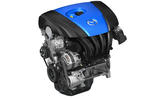The next generation of Mazda's petrol-powered models are likely to feature a 30 per cent increase in real-world economy thanks to new engines with diesel-like combustion technology.
So efficient is its latest internal combustion engine technology, the Japanese firm claims that it could even eclipse pure electric cars for well-to-wheel CO2 emissions, without adding expensive and heavy hybrid or plug-in hybrid components.
The firm has already stated it has no plans to launch hybrid models in Europe before 2020 as it believes it can meet strict upcoming CO2 emissions reduction targets without adopting hybrid or all-electric technology.
Currently in development in Japan, the innovative new engine key to the strategy is known as SkyActiv-G Generation 2.
It’s a follow-up to the firm’s current SkyActiv-G Generation 1 petrol engine range, which is already among the most efficient in the world for real-world fuel economy thanks to its lightweight construction, low friction and high compression ratio of 14:1.
For SkyActiv-G Generation 2, Mazda will adopt homogeneous charge compression ignition (HCCI) and an even higher compression ratio of 18:1. The HCCI system works in a similar manner to a diesel engine, using piston compression rather than a spark plug to ignite the mixture in the chamber.
The result, alongside a 30 per cent improvement in thermal efficiency, is a 30 per cent improvement in fuel economy. Mazda claims the total well-to-wheel CO2 emissions for an unspecified ‘average’ model equipped with a SkyActiv Generation 2 engine could be brought down to around 80g/km.
The technology behind the engine is similar to that featured on Mercedes’ Diesotto powerplant. Joachim Kunz, a senior manager at Mazda’s European R&D centre, says the HCCI system “mixes diesel and petrol processes, combining the best of both parts”.
In simple terms, the system allows a petrol engine to match and even surpass the efficiency of a diesel engine. It also eliminates harmful NOx emissions.
Kunz concedes there are problems to overcome, specifically HCCI's ability to work only under low loads at present. Mazda has so far got the technology to work on loads of up to around 50 per cent.
For this reason, the engine retains spark plugs for spark ignition under heavier loads, at which point a richer fuel-air mixture is used for combustion.
Kunz says Mazda is investigating the likes of cylinder deactivation in the engine and the firm is aiming “for the driver to not be able to tell the difference between different driving modes”.
Further ahead, Mazda is working on SkyActiv-G Generation 3 engines. These will adopt adiabatic combustion, which means that no heat is lost in combustion and the engine will be significantly more efficient again, with well-to-wheel CO2 emissions of around 60g/km for an 'average' model, an improvement of around 30 per cent again on SkyActiv-G Generation 2-powered models.
“This is the theoretical maximum and our target area,” says Kunz. He added that the combustion chamber and cylinder head would be insulated so “heat can be kept inside and used to drive the car and not be wasted".
Models equipped with SkyActiv-G Generation 3 engines would be much more efficient over a much wider band of revs and loads, eliminating the need for eight-speed-plus automatic gearboxes and long gear ratios.
These will be so efficent that Mazda believes it can add mild hybrid systems that draw no power from the engine and are powered purely by energy recouped under braking.
The hybrid system, likely based on Mazda’s current i-Eloop system which uses capacitors to store electricity and to power vehicle ancillaries, would only be used on low loads and low speeds when the car is at its least efficient, and should result in a model with well-to-wheel CO2 emissions of less than 50g/km with no heavy hybrid battery pack or systems.
That figure is equivalent to the well-to-wheel CO2 emissions of a pure-electric model, according to Mazda’s calculations.
“We think this is a fair comparison on the environmental impact of cars and we hope public opinion and legislation will consider our way of reducing emissions and not just focus on the tailpipe,” said Kunz.
“I’m not sure on the timescale of this, except that it will be on our next-generation of vehicles.”
With the first of the current generation of new Mazdas, the Mazda CX-5, introduced in 2012, it’s likely the SkyActiv-G Generation 2 technology could arrive in production before the decade is out.
“This is early launch information and development is ongoing,” Kunz added. “It’s not as far off as 2020, but we’re already at the stage where engines are running and prototypes are being developed. It’s not in the very far future.”











Join the debate
Add your comment
-
Mazda 6 petrol
Very Interesting